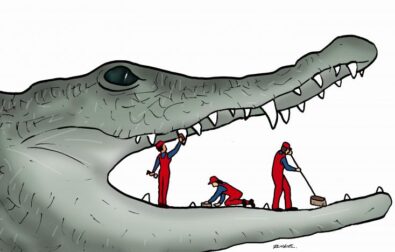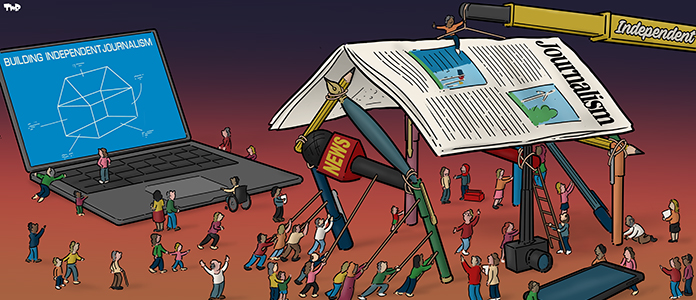The experience showed me that Baltic Rail really is necessary. The rails that are there are suitable for transporting neither passengers nor freight. Siim Kallas, the [Estonian] European Commissioner for Transportation told me how he had once asked, just out of curiosity, for a railway ticket from Berlin to Tallinn. They would have given it to him, but the journey would have gone via Moscow.
Those familiar with the state of the railways [in the region] confirm that you cannot travel by train from Europe up to Tallinn because somewhere between Lithuania and Poland the rails run out.
It was with great surprise, then, that I listened to a government official of the Harju County region who had called to offer me a ride from Berlin to Kaunas. “All the way by train?”, I asked, just in case. “By train, yes,” he confirmed. I decided to give this experiment a try in two seconds, and decided to go all the way to Tallinn, if it could be done.
Day 1
Friday, June 14. The Berlin-Warsaw Express. There is no railway station in Europe more pompous that the main railway station in the German capital: colossal, made of iridescent glass, looking out onto the German Chancellery and the Reichstag.
No time to stand around contemplating. The train pulls in right on time, at 5.37pm I am led to a special car, where I am served dinner. I feel like Hercule Poirot, who will have to solve a crime committed right there on the train. I appreciate the elegant movement of the long-distance train, not like that of the famous high-speed trains that hit speeds of 300km/h. Those trains do not roll East. The train to Warsaw travels at a top speed of 160km/h and over short sections slows down to 60-80km/h. “Since a new motorway was built, it can be faster to get there by car,” the marketing director of the railway line concedes sadly.
Interesting article?
It was made possible by Voxeurop’s community. High-quality reporting and translation comes at a cost. To continue producing independent journalism, we need your support.
Once the German-Polish border is behind us, we feel the East outside the windows. Regular applications of the brakes and bursts of acceleration give the ride a choppy feel. “It could be said that here the railway ends, and the Baltic begins!”, jokes a seasoned traveller.
11.14pm: The Express train pulls into Warszaw’s Central Station. It’s night already, but the journey has been bearable.
Day 2
Saturday, June 15. Special train Šeštokai-Warsaw-Kaunas [Poland-Latvia-Lithuania]. The train pulls out of Warsaw at 9.40am, headed for Lithuania. After half an hour, we grasp that the rails leading out of Warsaw to the north of the county date from another era. The speed is far from the advertised 120km/h. In Poland, the car is clearly more convenient than the train.
We stop at each level crossing – and there are hundreds of them – before the train gets back underway, whistling, at the speed of a pedestrian. “The Polish government is only interested in building highways, and mocks the railways”, explains the assistant of a Polish MEP who is travelling with me. “They have still not used the €2bn of European subsidies for the railway network”, he laments.
At midday, the train stops in Białystok. Here is where the electrical lines end, and our blue locomotive is replaced by a green locomotive, running on diesel. For half an hour it just sits and waits. In the north of Poland, in Suwałki, we sit patiently again for 45 minutes to let a train connecting Vilnius and Warsaw pass. Contrary to what I have been told, there is indeed a direct train that runs every day, admittedly without any comforts, between Vilnius and Warsaw.
For the last hour of the journey towards the Lithuanian border, the train chuffs along at 20-25km/h. But it’s here where we have the most beautiful views of the Polish landscapes and the many churches. While contemplating the landscape, I notice work being done on the rails. Arriving at Šeštokai, the relatively narrow railways of 1435mm gauge stop, and the broader 1520mm gauge of Russian railways begin. That means we have to change trains.
Lithuanian railway representatives tell me that they have reached an agreement that, by 2015, will let trains go straight through to Kaunas, thanks to the construction of a network to European standards. For the Lithuanians, this would be a first ever "Baltic Rail". The Estonians and Latvians, however, doubt that the Lithuanians intend to push the railway beyond their own borders.
After travelling for eight-and-a-half hours, what a pleasure it is to set foot on the platform in Kaunas! Half of the journey is behind me.
Day 3
Sunday, June 16. Kaunas-Vilnius, Vilnius-Daugavpils. For the Kaunas to Vilnius leg, I continue on my journey alone. The new red double-decker carriages are a surprise, and the ride is quick and pleasant. On pulling in at Vilnius, however, reality catches up. The next train, between Lithuania and Latvia, passes through Saint Petersburg. Genuine Soviet nostalgia: the train, full to overflowing, starts off with a series of clicks. The carriage seats are incredibly cramped. As the passengers settle down to sleep, Russian disco crackles over the public address. Arriving in Daugavpils at 10pm, I wonder if this trip can get any bleaker.
Day 4
Monday, June 17. Daugavpils-Riga, Riga-Valga, Valga-Tartu-Tallinn. The streets of Daugavpils are empty at night and early in the morning. In Latvia there are the same old diesel trains as there are in Estonia. I try to take an interest in what I see through the windows, but the four days of travel by train are starting to make themselves felt. Stops are frequent. Before we reach Riga, there are a total of 19. While the Latvian railway stations have been done up very well, that can’t be said for the railways themselves. The Riga-Valga train runs extremely slowly and stops everywhere.
Climbing onto the Tallinn-Valga train in Estonia, I feel just about clobbered. The minutes between the last stops (33 in all) crawl past. A few stations out of Tallinn, one of the customer advisors who works for the operator of the “Edelaraudtee” train, asks me how I can handle travelling this route without hardly moving. “Oh, it is nothing. I started four days ago in Berlin," I said.
“You must be sick of all the red lights”, she says with sympathy.
And it’s true. I give up. I will not make it to Tallinn station. At the next stop, the nearest to where I live, I get off.











